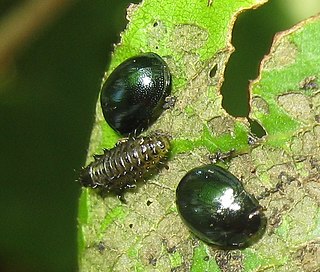
The insects of the beetle family Chrysomelidae are commonly known as leaf beetles, and include over 37,000 species in more than 2,500 genera, making up one of the largest and most commonly encountered of all beetle families. Numerous subfamilies are recognized, but the precise taxonomy and systematics are likely to change with ongoing research.

The tansy beetle is a species of leaf beetle. It measures 7.7–10.5 mm in length and has a characteristic bright metallic green colouration. The common name derives from the tansy plant on which they often feed as both larvae and adults. In addition to the nominotypical subspecies, which repeats the specific name, C. graminis graminis, there are five further distinct subspecies of tansy beetle, which, collectively, have a Palearctic distribution, although in the majority of countries where it is found the species is declining. In the United Kingdom it is designated as 'Nationally Rare' and this localised population, centred on York, North Yorkshire, has been the subject of much recent research.

The Tenebrionoidea are a very large and diverse superfamily of beetles. It generally corresponds to the Heteromera of earlier authors.

The scarlet lily beetle, red lily beetle, or lily leaf beetle, is a leaf beetle that eats the leaves, stem, buds, and flowers, of lilies, fritillaries and other members of the family Liliaceae. It lays its eggs most often on Lilium and Fritillaria species. In the absence of Lilium and Fritillaria species, there are fewer eggs laid and the survival rate of eggs and larvae is reduced. It is now a pest in most temperate climates where lilies are cultivated.

A leaf miner is any one of numerous species of insects in which the larval stage lives in, and eats, the leaf tissue of plants. The vast majority of leaf-mining insects are moths (Lepidoptera), sawflies, and flies (Diptera), though some beetles also exhibit this behavior.
The Chinese Elm cultivar Ulmus parvifolia 'Geisha' is a dwarf variety.
The Chinese Elm cultivar Ulmus parvifolia 'Todd' was developed by Fleming's Nurseries in Victoria, Australia, and registered in 2001.
The American Elm cultivar Ulmus americana 'Littleford' was cloned from a tree in Hinsdale, Illinois, circa 1915 and first released in 1927.
The American Elm cultivar Ulmus americana 'Jackson' was cloned from a selection made at Wichita, Kansas, which had reputedly shewn no signs of Dutch elm disease damage at >50 years of age.

The Siberian elm cultivar Ulmus pumila 'Dwarf Weeper' was discovered in a western Illinois garden and sold by the Arborvillage Nursery Holt, Missouri.
The Chinese Elm cultivar Ulmus parvifolia 'Nire-keyaki' is a dwarf variety principally used for bonsai.
The Chinese Elm cultivar Ulmus parvifolia 'Taiwan' is a small, evergreen tree from Taiwan.

Xanthogaleruca luteola, commonly known as the elm-leaf beetle, is a beetle species in the family Chrysomelidae that is native to Europe but invasive in other parts of the world.

Gonioctena fornicata is a species of broad-shouldered leaf beetles belonging to the family Chrysomelidae, subfamily Chrysomelinae.
The Chinese Elm cultivar Ulmus parvifolia 'Blizzard' arose in 2001 from a sport mutation on a tree growing in the Louisville Gardens, Kentucky. It was cloned at the Mast Arboretum of the Stephen F. Austin State University, Nacogdoches, Texas.

Gonioctena is a genus of broad-shouldered leaf beetles belonging to the family Chrysomelidae, subfamily Chrysomelinae.

Chrysomelini is a tribe of leaf beetles in the family Chrysomelidae. There are at least 140 described species in Chrysomelini.
Gonioctena americana, the American aspen beetle, is a species of leaf beetle in the family Chrysomelidae. It is found in North America.
Gonioctena nivosa is a species of leaf beetle in the family Chrysomelidae. It is found in Europe & Northern Asia.








